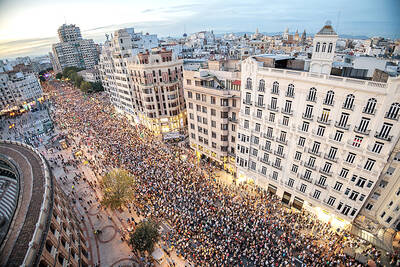A collision 160 million years ago of two asteroids orbiting between Mars and Jupiter sent many big rock chunks hurtling toward Earth, including the one that zapped the dinosaurs, a trio of scientists said on Wednesday.
Their research offered an explanation for the cause of one of the most momentous events in the history of life on Earth -- a 10km-wide meteorite striking Mexico's Yucatan Peninsula 65 million years ago.
The smash drove a giant sliver of rock into Earth's path, eventually causing the climate-changing impact that ended the reign of the dinosaurs and enabled the rise of mammals.
The impact is thought to have triggered a worldwide environmental cataclysm, expelling vast quantities of rock and dust into the sky, unleashing giant tsunamis, sparking global wildfires and leaving Earth shrouded in darkness for years.
Mixing skills in carbon chemistry, time travel and jigsaw-making, US and Czech researchers -- William Bottke, David Vokrouhlicky and David Nesvorny of Southwest Research Institute in Colorado -- carried out a computer simulation of the jostling among orbital rubble left from the building of the Solar System.
The results of their research was reported in this week's issue of the journal Nature.
They were guided by an intriguing clue -- a large asteroid called (298) Baptistina, which shares the same orbital track as a group of smaller rocks.
Turning the clock back, the simulation found that the Baptistina bits not only fitted together, they were also remnants of a giant parent asteroid, around 170km across, that once cruised the innermost region of the asteroid belt.
Around 160 million years ago -- the best bet in a range of 140-190 million years -- this behemoth was whacked by another giant some 60km across.
From this soundless collision was born a huge cluster of rocks, including 300 bodies larger than 10km and 140,000 bodies larger than 1km.
Over aeons, the fragments found new orbits with the help of something called the Yarkovsky effect, in which thermal photons from the Sun give a tiny yet inexorable push to orbiting rocks.
As the family gradually split up, a large number of chunks -- perhaps one in five of the bigger ones -- crept their way out of the asteroid belt and became ensnared by the gravitional pull of the inner planets.
Around 65 million years ago, a 10km piece crunched into Earth blasting out the Chicxulub Crater -- which measures about 180km -- and unleashing a firestorm and kicking up clouds of dust that filtered out sunlight.
The event is called the Cretaceous/Tertiary Mass Extinction. In this enduring winter, much vegetation was wiped out and the species that depended on them also became extinct. Only those animals that could cope with the new challenge, or could exploit an environmental niche, survived.
"Dinosaurs were around for a very long time. So the likelihood is they would still be around if that event had never taken place," Bottke said.
"Was humanity inevitable? Or is humanity just something that happened to arise because of this sequence of events that took place at just the right time. It's hard to say," he said.
The researchers estimated that there also was about a 70 percent probability that the prominent Tycho crater on the moon, formed 108 million years ago and measuring about 85km across, was also carved out by a remnant of the earlier asteroid collision.

DOUBLE-MURDER CASE: The officer told the dispatcher he would check the locations of the callers, but instead headed to a pizzeria, remaining there for about an hour A New Jersey officer has been charged with misconduct after prosecutors said he did not quickly respond to and properly investigate reports of a shooting that turned out to be a double murder, instead allegedly stopping at an ATM and pizzeria. Franklin Township Police Sergeant Kevin Bollaro was the on-duty officer on the evening of Aug. 1, when police received 911 calls reporting gunshots and screaming in Pittstown, about 96km from Manhattan in central New Jersey, Hunterdon County Prosecutor Renee Robeson’s office said. However, rather than responding immediately, prosecutors said GPS data and surveillance video showed Bollaro drove about 3km

Tens of thousands of people on Saturday took to the streets of Spain’s eastern city of Valencia to mark the first anniversary of floods that killed 229 people and to denounce the handling of the disaster. Demonstrators, many carrying photos of the victims, called on regional government head Carlos Mazon to resign over what they said was the slow response to one of Europe’s deadliest natural disasters in decades. “People are still really angry,” said Rosa Cerros, a 42-year-old government worker who took part with her husband and two young daughters. “Why weren’t people evacuated? Its incomprehensible,” she said. Mazon’s

‘MOTHER’ OF THAILAND: In her glamorous heyday in the 1960s, former Thai queen Sirikit mingled with US presidents and superstars such as Elvis Presley The year-long funeral ceremony of former Thai queen Sirikit started yesterday, with grieving royalists set to salute the procession bringing her body to lie in state at Bangkok’s Grand Palace. Members of the royal family are venerated in Thailand, treated by many as semi-divine figures, and lavished with glowing media coverage and gold-adorned portraits hanging in public spaces and private homes nationwide. Sirikit, the mother of Thai King Vajiralongkorn and widow of the nation’s longest-reigning monarch, died late on Friday at the age of 93. Black-and-white tributes to the royal matriarch are being beamed onto towering digital advertizing billboards, on

POWER ABUSE WORRY: Some people warned that the broad language of the treaty could lead to overreach by authorities and enable the repression of government critics Countries signed their first UN treaty targeting cybercrime in Hanoi yesterday, despite opposition from an unlikely band of tech companies and rights groups warning of expanded state surveillance. The new global legal framework aims to bolster international cooperation to fight digital crimes, from child pornography to transnational cyberscams and money laundering. More than 60 countries signed the declaration, which means it would go into force once ratified by those states. UN Secretary-General Antonio Guterres described the signing as an “important milestone,” and that it was “only the beginning.” “Every day, sophisticated scams destroy families, steal migrants and drain billions of dollars from our economy...